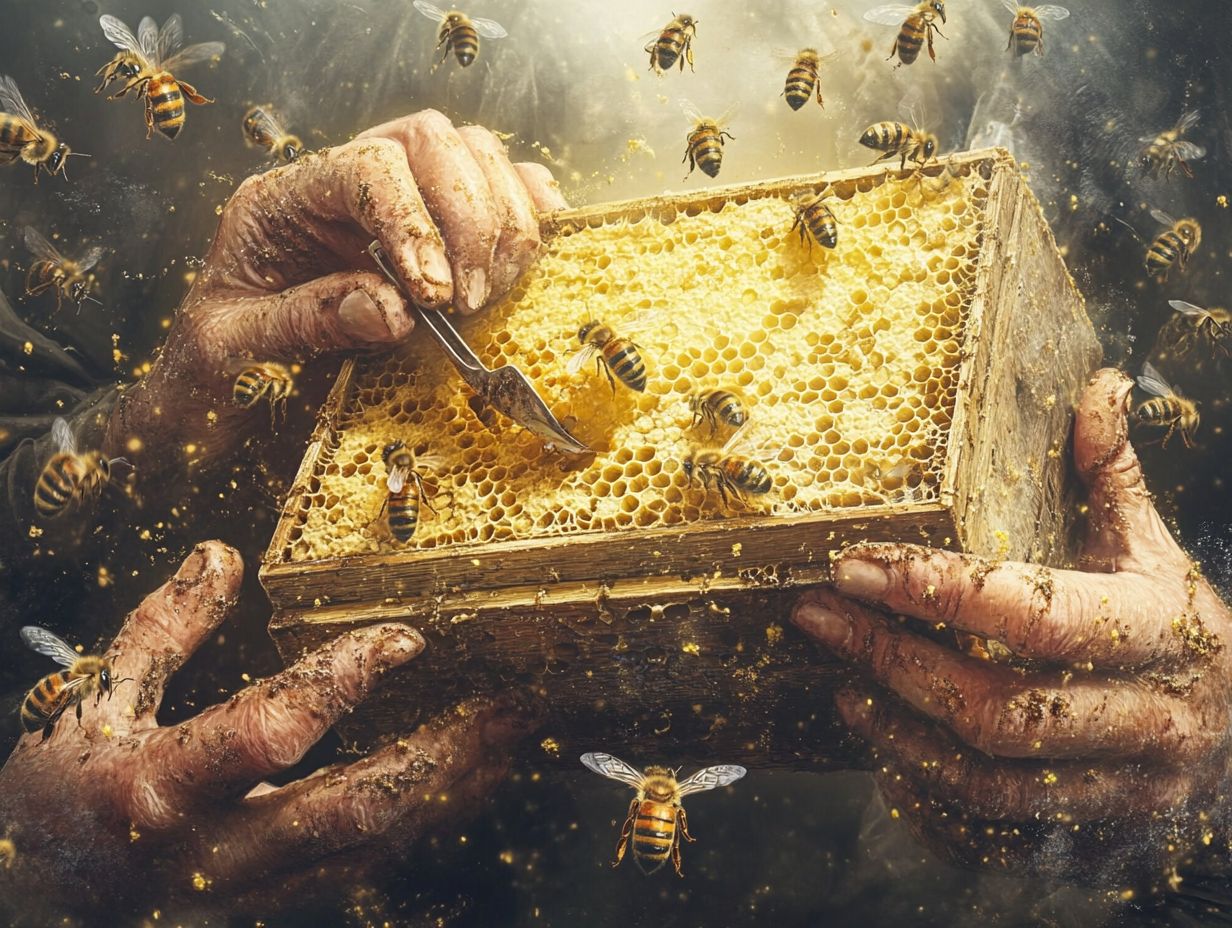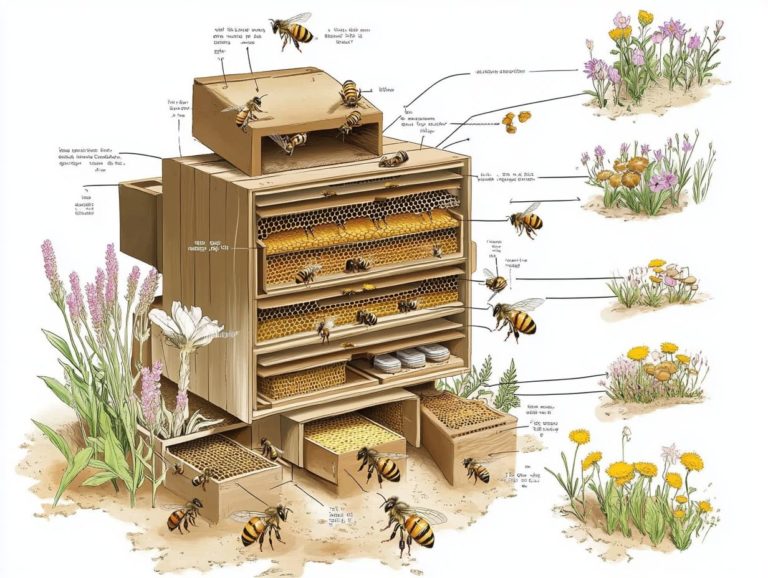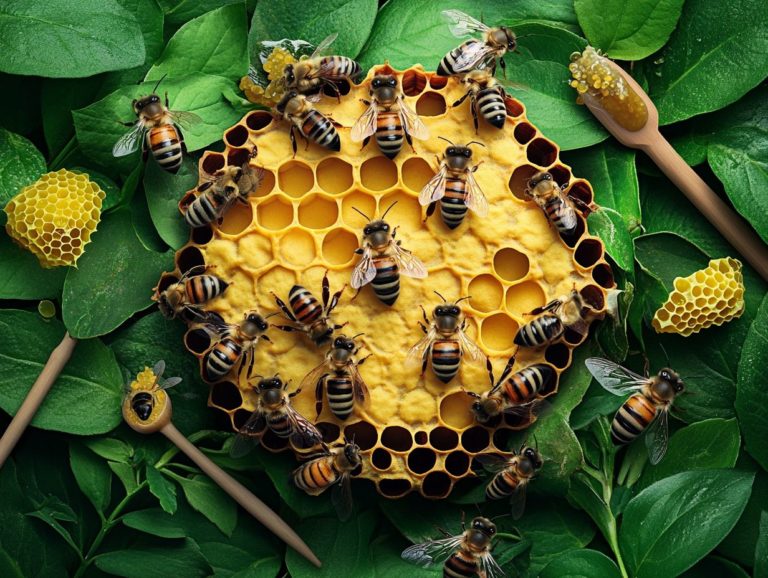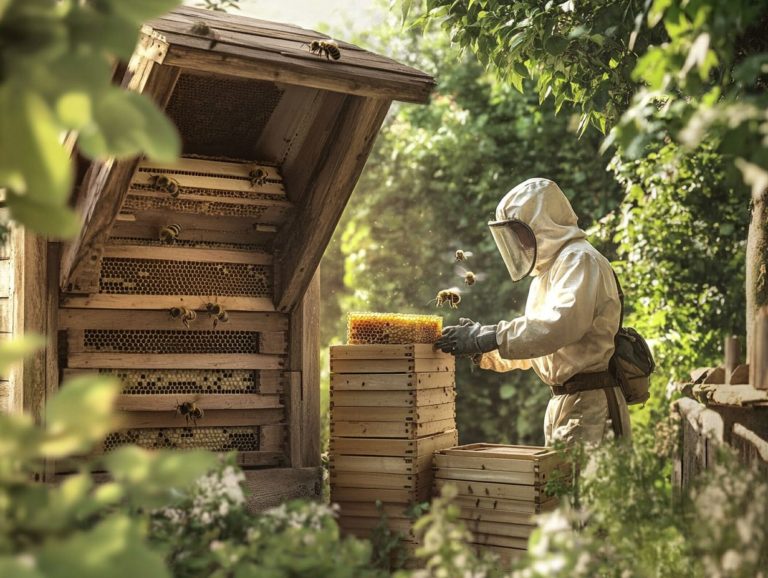How to Use Hive Tools Effectively
Beekeeping offers a rewarding experience, but it demands the right beekeeping equipment to ensure both success and safety.
Hive tools are indispensable for managing bee colonies, whether you re inspecting hives or harvesting honey. This article delves into the various types of hive tools, such as the J hook and multifunction scraper, that are essential for both novices and seasoned beekeepers alike.
You ll learn how to use each tool effectively, uncover advanced options at your disposal, and grasp the significance of safety and maintenance. By the end, you ll be thoroughly equipped to elevate your beekeeping practices, whether in a small bee yard or a larger apiary, to new heights.
Contents
- Key Takeaways:
- What are Hive Tools?
- Why are Hive Tools Important for Beekeeping?
- What Are the Basic Hive Tools Needed for Beekeeping?
- What are the Advanced Hive Tools for Experienced Beekeepers in Beekeeping?
- What Safety Measures Should Be Taken When Using Hive Tools for Beekeeping?
- How to Maintain and Clean Hive Tools for Effective Hive Management?
- The Dream Bee: A Beekeeping Journey
- Frequently Asked Questions
Key Takeaways:

- Hive tools are essential for effective beekeeping and come in various types, each with a specific purpose.
- Proper use of hive tools is crucial for the safety and well-being of the beekeeper and the bees. Hive tool safety and maintenance are key aspects to consider.
- Regular maintenance and proper storage of hive tools can prolong their lifespan and keep them in good working condition.
What are Hive Tools?
Hive tools are important tools crafted specifically for beekeeping, designed to streamline the myriad tasks associated with managing beehives. These tools assist you in inspecting the hive, maintaining hive components, and ensuring the overall health of your bees.
As you advance in your beekeeping journey, grasping the various types of hive tools available and their specific applications becomes essential. Whether you’re cleaning the hive, conducting inspections, or harvesting honey, each tool serves an important part in effective beehive management.
The thoughtful design and functionality of these tools not only enhance safety and efficiency but also minimize stress on the bees an absolute must for successful beekeeping.
What are the Different Types of Hive Tools?
In beekeeping, you ll find a range of hive tools designed to make managing your beehives a breeze, with each tool tailored to meet your specific needs. Among the most essential are the J hook for lifting frames and multifunction scrapers for cleaning.
Additionally, there are specialized hive scrapers that effectively remove propolis, a sticky substance bees make from tree resin, and burr comb. Familiarizing yourself with these different styles of hive tools is crucial; it allows you to select the right tools for your tasks, which ultimately enhances the efficiency and safety of your hive inspections and maintenance.
Among these tools, the bee brush truly shines. It gently clears bees away from frames without causing them harm, making it an important companion during honey extraction. The frame lifter is another game-changer, effortlessly lifting heavy frames, especially those brimming with honey.
And let s not overlook the smoker; it plays a vital role in calming the bees, creating a more serene working environment for you as the beekeeper.
Each of these tools not only streamlines the practicalities of hive management but also supports the overall wellbeing of your bee colonies, directly influencing both honey production and hive health. Be sure to explore different hive tool styles and recommendations to find the best hive tool for your needs.
Why are Hive Tools Important for Beekeeping?
Hive tools are important in your beekeeping journey, playing a crucial role in tasks like hive inspections, maintenance, and pest control. These specialized instruments not only boost your efficiency as a beekeeper but also significantly enhance the health and productivity of your bee colonies by helping you manage issues like small hive beetles and wax moth infestations.
With the right hive tools at your disposal, you can inspect for problems like small hive beetles or wax moths and perform necessary maintenance to create an ideal environment for honey production. Moreover, using these tools correctly minimizes stress on the bees, which is vital for their well-being and the overall health of your hive.
Explore these tools and gear up for a successful beekeeping adventure!
What Are the Basic Hive Tools Needed for Beekeeping?
To embark on your successful beekeeping journey, it s essential to have the right hive tools at your disposal. These tools are vital for effective inspections and maintenance, becoming your best companions in managing your beehives and ensuring their health.
You ll need a hive scraper for cleaning, frame lifters to safely handle those precious frames, and protective clothing, like a bee suit, to ensure your safety while navigating the bee yard. Beekeeping supplies from reputable brands like Dadant & Sons can provide you with high-quality tools.
Don’t overlook the importance of a smoker. This key tool calms the bees during inspections. A bee brush will also be handy for gently easing bees away from the frames.
Equip yourself with these must-have tools! They will not only make your hive inspections easier but also transform your entire beekeeping adventure.
How to Use a Smoker?
A smoker is a key tool in beekeeping. It calms the bees and helps you inspect hives safely. A smoker generates smoke by burning materials like wood chips or burlap. When you introduce this smoke into the hive, it masks the alarm pheromones chemicals released by bees to signal distress effectively reducing their defensive behavior.
To use a smoker effectively, start by filling it with your chosen material and lighting it. Ensure that the smoke produced is cool rather than hot to avoid harming the bees. This technique is crucial for ensuring a peaceful hive inspection and minimizing stress on your bees.
Once your smoker is lit and producing that cool smoke, maintain a steady flow while you inspect the hive. Be gentle with the puffs from the smoker; heavy doses of smoke can overwhelm the bees and create unnecessary chaos.
Wearing protective gear is crucial for your safety. Even the calmest bees can become agitated if they sense a threat. Before any hive inspection, check the weather conditions, as bees tend to be more aggressive in hot or overcast weather.
By fostering a calm environment and adhering to these best practices, you can effectively manage bee behavior during inspections. This ultimately promotes a healthier hive. Proper tool organization and storing equipment correctly also play a vital role in maintaining a peaceful beekeeping environment.
How to Use a Hive Tool?

Mastering the use of a hive tool is essential for effective hive inspections and maintenance. This versatile tool, featuring a flat end and often a serrated edge, is designed to pry apart hive boxes, lift frames, and scrape off excess materials like bee propolis and burr comb. Remember to use the hive tool gently; this careful approach protects the bees and preserves the structural integrity of the hive.
When prying open a hive box, slide the flat end of the tool into the gap created by the bees working to seal the box. This technique allows for a smooth lift while minimizing disturbance to the colony. When lifting frames, the serrated edge is particularly useful for scraping away built-up wax or debris, ensuring that the frames slide out effortlessly.
Maintaining a clean hive tool, free of contaminants, is vital to prevent the spread of diseases between hives. Such safety practices not only protect your bees but also contribute to the overall health of the hive. This demonstrates that proper tool handling is an essential aspect of responsible beekeeping, underscoring your commitment to their well-being.
How to Use a Bee Brush?
A bee brush is an essential tool in your beekeeping arsenal, carefully designed to help you gently move bees away from frames and other hive components during inspections. With its soft bristles, this brush allows you to remove bees without causing harm or unnecessary distress.
This makes it easier to access honey frames or conduct necessary checks. Mastering the proper technique for using a bee brush is vital. It not only ensures stress-free examinations but also significantly contributes to the overall health of your hive.
By maintaining a calm demeanor and using short, sweeping motions, you can encourage the bees to move aside without swatting at them or causing panic. This respectful interaction prevents injuries and strengthens the all-important connection between you and the colony.
When you integrate the bee brush with other hive tools, like a smoker to soothe the bees, you enhance the effectiveness of your inspections. This thoughtful approach ultimately supports productive beekeeping practices and fosters a thriving hive.
How to Use a Frame Grip?
Using a frame grip is essential for safely handling frames during hive inspections. This tool allows you to lift and maneuver frames securely without squishing any bees.
A frame grip usually comes with a handle and gripping ends that hold the frame firmly, making it much easier to inspect, replace, or harvest honey. To use it, simply position the grip around the frame and lift gently, ensuring it s secure to prevent any drops that could harm the bees.
Using a frame grip reduces physical strain and offers better visibility of the hive’s contents, leading to more thorough inspections. It’s wise to consider using hive tools, such as smokers, to calm the bees before getting started.
By carefully lifting each frame, you can gain valuable insights into the colony s health. You’ll be able to identify potential issues early and perform necessary interventions. Mastering the use of these tools protects you and minimizes stress on the bees, fostering a healthier hive environment.
What are the Advanced Hive Tools for Experienced Beekeepers in Beekeeping?
For seasoned beekeepers, advanced hive tools are critical for optimizing hive management and streamlining various tasks. Using proper beekeeping equipment, including frame lifters and multifunction scrapers, enhances the efficiency of your beekeeping practices.
- Queen catchers: Handle the queen bee with precision during hive inspections.
- Frame spacers: Ensure proper spacing between frames, enhancing ventilation and minimizing issues like burr comb and small hive beetles.
- Propolis scrapers: Help you manage propolis build-up effectively.
- Bee escapes: Allow bees to exit the super without returning, facilitating honey harvesting.
By mastering the use of these advanced tools, you can significantly boost hive productivity and elevate your beehive management to new heights.
How to Use a Queen Catcher in Your Beekeeping Journey?
A queen catcher is a game-changer for beekeepers needing to manage the queen bee during inspections or hive manipulations. This specialized tool enables you to capture and hold the queen safely, ensuring her well-being during tasks like re-queening or checking her health.
Effective use of a queen catcher simplifies handling the queen and minimizes stress on the entire colony. Approach the hive calmly, as sudden movements can agitate the bees and make the process more challenging.
Once you secure the queen in the catcher, you can conduct thorough inspections or even reassign her to a different hive if necessary. Regularly monitoring her health is crucial keep a close eye on it, as it directly impacts the vitality and productivity of the colony.
By incorporating this tool into your standard beekeeping practices, you can cultivate a more harmonious environment and achieve better overall hive management. Are you ready to take your beekeeping to the next level with these advanced tools?
Want to keep your bees happy? A frame spacer is your secret weapon!
A frame spacer is an essential hive tool that guarantees proper spacing between frames in your beehive, enhancing air circulation and preventing overcrowding issues.
To use a frame spacer, simply insert it between the frames to create the ideal gap. This gap is crucial for maintaining the health and productivity of your hive. This tool is one of the beekeeping supplies you should always have in your bee yard.
This tool is particularly invaluable during inspections and when adding new frames or boxes, ensuring your bees have ample space to thrive.
By employing a frame spacer effectively, you contribute to successful hive maintenance and management.
Utilizing a frame spacer can significantly streamline your beekeeping workflow. Its thoughtful design allows for quick adjustments, accommodating the ever-evolving dynamics of your bee colonies. Remember, maintaining the right spacing not only promotes airflow but also aids in moisture control, reducing the risk of disease transmission among your hive’s inhabitants.
As you add new frames or supers, regularly check the spacer’s position to ensure your bees can access all areas of their home with ease. Ultimately, this simple yet powerful hive tool plays a pivotal role in elevating your beekeeping efficiency and fostering a thriving environment for your bees.
How to Use a Propolis Scraper for Cleaning Hive Components?

Using a propolis scraper is vital for you to maintain a clean and healthy beehive. This tool removes excess bee propolis that can block important hive components.
Designed with a flat edge, a propolis scraper allows you to remove that sticky substance without harming the wooden surfaces of your hive. It is one of the best hive tools for cleaning hive components.
To use it, simply slide the edge under the propolis buildup and lift it away. This ensures your bees enjoy a clean and well-maintained environment.
Make it a habit to use this tool regularly. It enhances hive management and promotes overall bee health.
By making a habit of using a propolis scraper, you can prevent the buildup of this natural resin. Propolis is a sticky substance made by bees from tree resin. While it offers beneficial antimicrobial properties, it can lead to unsanitary conditions if neglected. This maintenance is crucial not only for keeping things looking tidy but also for improving airflow and ensuring easy access to essential hive components like frames and supers.
Regular cleaning helps in managing pests like wax moths and small hive beetles. Removing excess propolis streamlines your hive inspections, allowing you to monitor your colonies with greater efficiency.
With diligent use of the scraper, you create a harmonious environment that supports your bees’ ability to thrive and produce honey. This reinforces the importance of cleanliness in effective hive management.
How to Use a Bee Escape for Honey Harvesting?
A bee escape is an innovative hive tool crafted to transform your honey harvesting experience by allowing bees to exit the honey supers while cleverly preventing their re-entry. This tool becomes invaluable when you prepare for honey extraction, ensuring that your honey supers are free of bees. This makes the process smoother and significantly less stressful.
Utilizing the bee escape is one of the key beekeeping practices for effective honey harvesting.
To utilize a bee escape, simply place it on top of the honey super, ensuring it s sealed properly to keep those busy bees from returning. Mastering the use of this tool not only enhances your hive management but also streamlines your honey harvesting efforts.
Before you install the bee escape, it s crucial to confirm that the honey is capped, meaning that the honey cells are sealed by bees, indicating that the honey is ready for harvesting. By positioning the bee escape on top of the super with the narrow end facing the bee entrance, you encourage the bees to disperse and make their exit.
After allowing a generous window of 24 to 48 hours, you ll find that the escape has effectively cleared out the majority of bees. With the supers now emptied, you can confidently proceed to harvest your honey without the added distraction of buzzing bees.
By mastering this device, you promote a more efficient honey collection process and contribute to the overall health and productivity of your bee colony.
What Safety Measures Should Be Taken When Using Hive Tools for Beekeeping?
Implementing proper safety measures while using hive tools is essential for ensuring the safety of both you and your bees during inspections and maintenance.
Your journey towards safety begins with donning appropriate protective clothing, such as a bee suit, gloves, and a veil, all designed to minimize the risk of bee stings. These are crucial elements of protective clothing in beekeeping.
Using hive tools correctly can greatly reduce accidents and enhance your overall effectiveness in hive management. By embracing these safety measures, you not only protect yourself but also create a harmonious environment for the bee colony, allowing them to thrive without unnecessary stress. Hive tool safety is an integral part of responsible beekeeping practices.
How to Properly Handle and Store Beekeeping Equipment?
Proper handling and storage of your hive tools are crucial for ensuring their longevity and functionality in your beekeeping journey. This also applies to cleaning tools and other types of hive equipment.
By using these tools with care, you can prevent the wear-and-tear that could compromise their performance.
Always remember to sanitize your hive tools to keep your bees healthy. This means cleaning them to remove germs and prevent disease, especially after working with different colonies to avoid spreading illnesses.
Protecting tools from rust or mildew is also essential for their longevity. Consider investing in a dedicated toolbox or a pegboard system that promotes air circulation around each tool.
This approach not only protects your equipment from rust or mildew but also keeps everything visible and organized. Proper equipment storage and tool organization are key elements in maintaining a well-functioning bee yard.
Labeling your storage area can significantly boost your efficiency and help you avoid missing vital maintenance tasks, making your hive management smoother and more effective.
What to Do if Stung by Bees While Using Beekeeping Tools?
Experiencing a bee sting while using hive tools is just one of those realities in the world of beekeeping, and knowing how to respond is essential for your personal safety.
If you find yourself on the receiving end of a sting, the first thing to do is stay calm flailing about or swatting at the bees will only provoke them further. This is one of the hive tool safety tips every beekeeper should know.
Quickly remove the stinger with a firm scraping motion to minimize venom release. Then, apply a cold compress to alleviate swelling and discomfort.
Having a well-stocked first aid kit with bee sting treatment supplies ensures that you’re prepared for any sting incidents that may arise while managing your hive.
Keep in mind that bee stings are simply part of the beekeeping journey, and maintaining a calm demeanor can truly make a world of difference. Wearing protective clothing, like gloves and a veil, greatly reduces the likelihood of getting stung, but let’s be honest, accidents happen.
After you’ve dealt with the immediate aftermath, pay attention to how your body responds; some individuals may experience allergic reactions. Having antihistamines readily available can be a lifesaver.
If you notice the sting site worsening or experience any signs of an allergic reaction such as hives, swelling in the throat, or difficulty breathing don’t wait get medical help right away!
By taking these precautions and understanding the right steps to follow, you can manage your hive with greater safety and confidence, much like the beekeeping experts at Dadant & Sons.
How to Maintain and Clean Hive Tools for Effective Hive Management?
Maintaining and cleaning your hive tools is an essential part of beekeeping that ensures their effectiveness and longevity. This ultimately supports the health of your bee colonies. Follow these hive maintenance tips for the best results.
Regular cleaning prevents the accumulation of bee propolis, wax, and debris. These can hinder the performance of your tools and invite pests like Small Hive Beetles and wax moths into the hive. To clean your hive tools, which include the J hook and multifunction scraper, simply mix warm soapy water with a gentle scrub. Afterward, ensure a thorough drying to prevent rust. This is crucial for maintaining hive components and ensuring effective hive management.
By implementing these maintenance practices, such as regular hive inspections and cleaning your tools, you not only extend their lifespan but also elevate your entire beekeeping experience. Proper beekeeping equipment and protective clothing can enhance your journey and ensure effective pest control in your bee yard.
The Dream Bee: A Beekeeping Journey

Start your amazing beekeeping adventure today with the right supplies from Dadant & Sons. Essential tools such as the frame lifter, hive scraper, and smoker are must haves for every beekeeper. From honey harvesting to inspecting hive components, each step requires the best hive tools and proper practices.
Frequently Asked Questions
What are Hive Tools?
Hive tools are essential equipment used in beekeeping. They include various implements necessary for managing hives effectively.
How do I access and use Hive Tools effectively?
To access Hive Tools, you can use the Hive command line interface or a graphical user interface like Hue. Once accessed, you can use various commands and functions to query and manipulate data efficiently. Understanding the types of hive tools and their specific applications can enhance your capabilities.
What are some best practices for using Hive Tools?
Best practices include optimizing your approach, using partitioning (dividing data into smaller pieces) and bucketing (grouping data for easier access), and understanding the underlying schema. Regularly monitoring performance will help achieve better results. Organizing your equipment storage helps keep your tools in order.
Can I use Hive Tools for real-time data analysis?
No, Hive Tools are not designed for real-time data analysis. They are better suited for batch processing of large datasets. For real-time analysis, consider using tools like Spark or Kafka. However, Hive Tools excel in managing and querying large datasets, making them essential in data warehousing.
How can I troubleshoot issues while using Hive Tools?
If you encounter issues, refer to the Hive documentation for troubleshooting steps. Checking error logs and consulting the Hive community can provide insights or solutions. Proper hive maintenance tips and understanding safety can also prevent many common issues.
Are there any limitations to using Hive Tools?
Yes, while Hive Tools are powerful for analysis, they have limitations. These may include slower performance compared to other tools and difficulty in handling complex data types. Understanding these limitations and selecting the best hive tools for specific tasks can help mitigate some challenges.






